Alison Carrington,
Graduate Practitioner, Paua Clinic
The Good Oil
Omega-3 Fatty Acids: What are they? Why do we need them? And where to we get them?
Omega-3 Essential Fatty Acids are talked about a lot in the media and most of us know they are closely linked with good health, so lets look at why they get so much attention. In a nutshell (walnut, preferably!) our bodies need Omega-3 Fatty Acids for a multitude of biological functions, but we are unable to make them, so we must obtain them from our diet (hence the term “essential” fatty acids). The three most important types of Omega-3 are ALA (alpha-linolenic acid), DHA (docosahexaenoic acid) and EPA (eicosapentaenoic acid). ALA is mainly found in plants, while DHA and EPA are mainly found in animal foods and algae.

Most of Omega-3’s benefits come from its anti-inflammatory effect on the body. Food such as oily fish, chia seeds, flaxseeds and walnuts are good sources. Omega-6’s are are also necessary, but in lesser amounts. They are primarily from plant and seed oils and are often found in processed food. They are relatively new to the humans, having only been introduced to our diets about 100 years ago, when we invented ways of extracting the oil. They are often heavily processed oils such as Sunflower, Corn, Soybean and Cottonseed. Many foods, for example butter, has both Omega-3 and Omega-6, helping with brain function and improving skin health.

More importantly, butter is also rich in fat-soluble vitamins and trace minerals, including beneficial selenium, a powerful antioxidant. Foods high in Omega-6 oils tend to be more pro-inflammatory, which is why it is important to consume the right ratio of Omega-3 to Omega-6 oils, as Omega-3 counteracts the harmful effects of Omega-6. In a typical Western diet, the ratio is weighted more towards Omega-6’s which can lead to many inflammatory health issues, primarily because excess inflammation is one of the biggest drivers of disease. These include: heart disease, metabolic syndrome, diabetes, arthritis, Alzheimer’s disease and many types of cancer. Anthropological evidence suggests that human beings evolved eating a ratio of around 1:1, while the ratio today is about 16:1! Animal foods are the best sources of Omega-3 fatty acids, however it’s best to avoid animals that have been grain-fed. This type of feed could contain soy and corn, which reduces the Omega-3 content, so the fats in the meat are mostly Omega-6. Therefore, grass-fed meat is definitely optimal.
A word about Hydrogenated and Partially Hydrogenated Oils
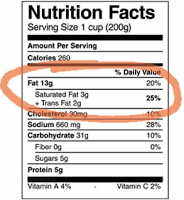
Also known as trans-fats, hydrogenated oils are a man-made product. These oils have a chemical structure that has been altered to prevent the oil becoming rancid, increasing its shelf life. Another reason why food manufacturers love using hydrogenated oils is that the process can turn a liquid oil into a solid, which makes it easier to transport, and this solid fat is generally cheaper than solid animal fats. The Harvard School of Public Health notes that trans-fats promote immune system over-activity and inflammation, and are linked to heart disease, stroke and diabetes and other chronic conditions. In addition to being chemically extracted from their source, chemicals are also used to mask the odour and change the taste of the oil. Trans-fats will be listed on the nutritional label of packaged foods, but bear in mind that other food, such as food from bakeries, takeaway shops and restaurants will often contain trans-fats. The intake of hydrogenated or partially hydrogenated vegetable oil increases LDL cholesterol (the “bad kind of cholesterol) and lowers HDL cholesterol, and damages the cells that line our blood vessels. Trans-fats are found in products such as margarine, vegetable shortening, baked goods and fried foods and should be avoided as they are damaging to our health.
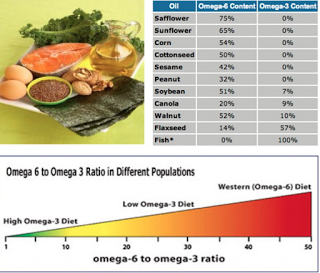
When Omega-3’s and Omega-6’s are metabolised, our bodies produce biochemical messengers called prostaglandins, which are involved in either the prevention or enhancement of pain and inflammation. The Mediterranean diet has a healthier balance between Omega-3 and Omega-6 fatty acids and studies have shown that people who follow this diet, which includes whole grains, fresh fruits and vegetables and fish, plus olive oil and garlic are less likely to develop heart disease and high cholesterol.
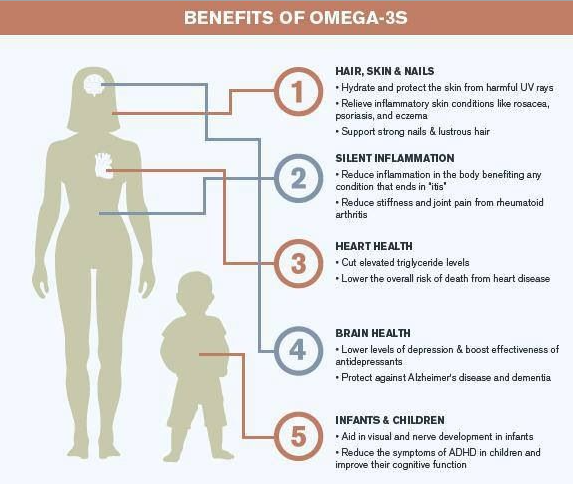
Signs of Omega-3 Deficiency can include:
- fatigue
- dry skin and skin conditions such as keratosis pilaris (“chicken skin”) on the backs of arms
- heart problems
- poor circulation
- mood swings, anxiety or depression
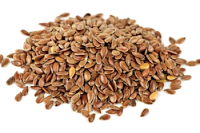
Cautions:
People with congestive heart failure (or any other condition where the heart is receiving insufficient blood flow), people taking insulin, people who bruise easily, people who have disorders involving bleeding and people who take blood thinners should get a doctor’s approval before taking fish oil supplements. Also, Omega-3’s can slightly lower blood pressure which could lead to hypotension for those already taking blood pressure medication.
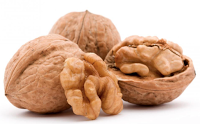
Sources of Omega-3 Fatty Acids
Salmon, tuna, herring, oysters, trout and other seafoods including crab, algae and krill. Meat, eggs and grass-fed dairy products, nuts and seeds such as walnuts and flaxseeds, along with their oils.
The take-home message here is to consume Omega-3 foods and whole foods as often and possible, and stay away from hydrogenated fats and processed food.
Salad with Flaxseed Oil Dressing

Ingredients
3 cups of romaine lettuce, chopped
2 cups mixed green, butter and leaf lettuce
¼ cup of flaxseed oil
Juice of 1 lemon
2 tablespoons soy sauce
1 tablespoon 100% maple syrup
¼ teaspoon ground black pepper
¼ teaspoon sea salt
- Chop greens and place in a large salad bowl.
- Drizzle flaxseed oil directly on greens and rotate bowl to evenly coat the greens with the oil.
- Squeeze the juice of one lemon directly onto the greens.
- Add soy sauce and maple syrup into bowl.
- With clean hands, toss the salad to evenly distribute the flaxseed oil dressing throughout the salad.
- Add sea salt and pepper to taste.
- Serve immediately.
References



